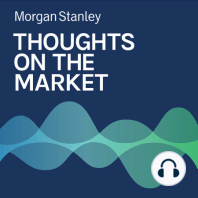3 min listen

An Atlantic-Sized Divide in Monetary Policy
An Atlantic-Sized Divide in Monetary Policy
ratings:
Length:
4 minutes
Released:
Feb 21, 2024
Format:
Podcast episode
Description
Central banks in the U.S. and Europe are looking to cut rates this year, but the path to those cuts differs greatly. Our Global Chief Economist explains this stark dichotomy.----- Transcript -----Welcome to Thoughts on the Market. I’m Seth Carpenter, Morgan Stanley’s Global Chief Economist. Along with my colleagues bringing you a variety of perspectives, today I’ll be talking about the challenges for monetary policy on both sides of the Atlantic.It’s Wednesday, Feb 21st at 10am in New York.The Fed, the Bank of England, and the ECB all hiked rates to fight inflation, and now we are looking for each of them to cut rates this year. For our call for a June Fed rate cut, both growth and inflation matter. But our call for a May and June start on the east side of the Atlantic depends only on inflation. “Data dependent” here has two different meanings.At the January Fed meeting, Chair Powell said continued disinflation like in prior months was needed to cut. But he also emphasized that disinflation needs to be sustainably on track; not simply touching 2 per cent. Until Thursday’s retail sales data, the market narrative began to flirt with a possible re-acceleration of the US economy, spoiling that latter condition of inflation going sustainably to target. January inflation data showed strength in services in particular, and payrolls showed a tight labor market that might pick up steam.The retail sales data pushed in the opposite direction, and we think that the slower growth will prevail over time. And for now, market pricing is more or less consistent with our call for 100 basis points of cuts this year, starting in June.Now the Fed’s situation is in stark contrast to that of the Bank of England. Last week’s UK data showed a technical recession in the second half of 2023. And while the UK economy is not collapsing, a strongly surging economy is not a risk either. But until the last print, inflation in the UK had been stubbornly sticky. The January print came in line with our UK economist’s call, but below consensus. But still, one swallow does not mean spring, and the recent inflation data do not guarantee our call for a May rate cut will happen. Rather, broader evidence that inflation will fall notably is needed; and for that reason, the risks to our call are clearly skewed to a later cut.For the ECB, the inflation focus is the same. And on Thursday, President Lagarde warned against cutting rates too soon – a particularly telling comment in light of the weak growth in the Euro area. Recent data releases suggest that not only did Germany’s GDP decline by three-tenths of a per cent in Q4 of 2023; the second largest economy, France, also experienced stagnation in the second half of the year. And with this weakness expected to persist – well, we forecast a weak half per cent growth this year and about only 1 per cent growth in 2025.So, why is this dichotomy so stark? The simple answer is the weak state of the economy in the UK and in Europe. More fundamentally, the drivers of inflation started with a jump in food and energy prices, and then surging consumer goods prices as disrupted supply chains met consumer spending shifting toward goods. That inflation has since abated but services inflation tends to be more tied to the real side of the economy. And for the US in particular, housing inflation is driven by the state of the labor market over time.The Bank of England and the ECB are waiting for services inflation to respond to the already weak economy, and there is little risk of a reacceleration of inflation if that happens. In contrast, the Fed cannot have conviction that inflation won’t reaccelerate because of the continued resilience on the real side of the economy. The retail sales data will help, but the pattern needs to continue.Thanks for listening. If you enjoy the show, please leave us a review on Apple podcasts, and share Thoughts on the Market with a friend or colleague today.
Released:
Feb 21, 2024
Format:
Podcast episode
Titles in the series (100)
Andrew Sheets: For Markets, Signs, Signs, Everywhere Signs by Thoughts on the Market